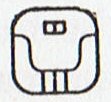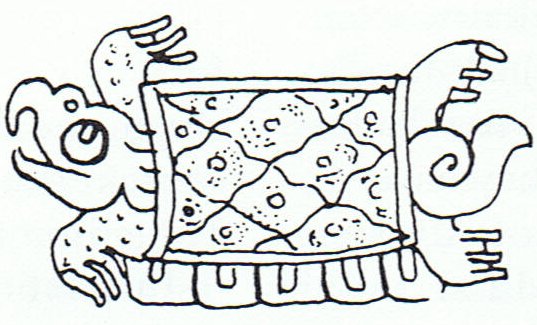In the Chinese system their 20th station was a Turtle:
The position at Heka maybe was only a definition of the right ascension of the Chinese Turtle, because the Mayas had their turtle below the Three Stars of the Belt of Orion:
Metoro used a method of reversal between kiore and henua when reading the E tablet and the same method may have been used by the Chinese to indicate a point of reversal between Heka and Alnitak (ζ Orionis, the last to rise of the 3 stars). The first of the Tau-toru stars was Mintaka (δ), rising at RA 82.4 i.e. slightly before Heka. Monkeys and gibbons are much the same. The 3 stars (stones) may have been connected with Alcyone, Pleione, and Atlas, which rose together 29 days earlier, 165 - 136 = 29 (= 329 - 300):
Probably the creators of Manuscript E were aware of the connection between Tautoru (the Belt Stars) and a 'Turtle'. ... No sooner had he pushed her up and lifted her completely off the ground when she struck Kuukuu with one fin. She struck downward and broke Kuukuu's spine. The turtle got up, went back into the (sea) water, and swam away. All the kinsmen spoke to you (i.e. Kuukuu): 'Even you did not prevail against the turtle!' Once, in the time of Julius Caesar, May 16 could have identified the last day of the winter season, when Heka was close to the Full Moon. In the following day (137) summer would then begin. South of the equator it would have been the opposite, with May 16 as the last day of the summer season and with May 17 as the first day of winter. If we should identify winter with the 'watery' part in the sky ('Sea') and summer with the 'dry' ('Land') part of the year, then the Chinese Turtle can be said to have coincided with the 'Shoreline' between 'Sea' and the following 'Land'. ... They all sat down and rested [on the plain of Oromanga], when suddenly they saw that a turtle had reached the shore and had crawled up on the beach. He [Ira] looked at it and said, 'Hey, you! The turtle has come on land!' At this time on Easter Island, however, the 'tide was rising' and in front was winter, not dry land: ... The turtle got up, went back into the (sea) water, and swam away. In other words the turtle reversed direction. Among the Mayas the name for this 'Turtle' could have been Pawahtun:
... An iconographic study by Jeff Kowalski suggests a cosmological layout for the Nunnery. The higher placement of the North Building, with its 13 exterior doorways (reflecting the 13 layers of heaven), and the celestial serpents surmounting the huts identify it with the celestial sphere. The iconography of the West Building, with 7 exterior doorways (7 is the mystic number of the earth's surface), and figures of Pawahtun - the earth god as a turtle - indicate this to be the Middleworld, the place of the sun's descent into the Underworld. The East Building has mosaic elements reflecting the old war cult of Teotihuacan, where tradition had it that the sun was born; thus, this may also be Middleworld, the place of the rising sun. Finally, the South Building has 9 exterior doorways (the Underworld or Xibalba had 9 layers), and has the lowest placement in the compex; it thus seems to be associated with death and the nether regions. Its position may once have been close to the end of the year and closely before the new food arrived, symbolized by the important maize (kan)
in the main element of Cumhu:
The square earth shell of this swimming turtle has 12 'counters' (1 of which is black and presumably indicating a place of origin). I guess this swimmer could illustrate the Sun carrying the water-drenched 'Earth' on his back, much like in the Pegasus-square. The Maize God rose up from the carapace of a turtle (earth), with water at his back and air in front:
| ||||||||||||||||||||||||||||||||||||||||||||||||||||||||||||||||||||||||||||||||||||||||||||||||||||||||||||||||||||||||||









